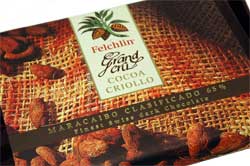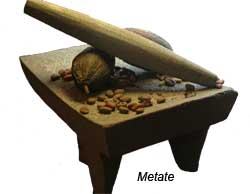 Cacao Beans - To understand today’s “chocolate math,” it’s helpful to understand something about the origins of chocolate. It all starts in tropics, just twenty degrees north and south of the equator. The favorable, tropical climate supports the growth of the cacao tree. (Pronounce cacao as kuh-cow). As an understory tree of the rainforest, their height averages only 20 feet. The trees produce pods on their branches and along its trunk, an odd and rare botanical ability known as cauliflory. The bumpy pods, resembling an elongated football, (6-12 inches long; 3-4 inches wide), are filled with a tough pulp that encases rows of seeds. Cacao Beans - To understand today’s “chocolate math,” it’s helpful to understand something about the origins of chocolate. It all starts in tropics, just twenty degrees north and south of the equator. The favorable, tropical climate supports the growth of the cacao tree. (Pronounce cacao as kuh-cow). As an understory tree of the rainforest, their height averages only 20 feet. The trees produce pods on their branches and along its trunk, an odd and rare botanical ability known as cauliflory. The bumpy pods, resembling an elongated football, (6-12 inches long; 3-4 inches wide), are filled with a tough pulp that encases rows of seeds.
The three primary types of cacao trees produce distinctive cacao seeds each with exceptional chocolate characteristics: The tree’s proper name, Theobroma cacao, translates literally into “food for the gods.” The three types of cacao trees are:
 Criollo– This variety produces the rarest and most expensive of cacao beans and is native to Central America, the Caribbean, and northern South America. Criollo– This variety produces the rarest and most expensive of cacao beans and is native to Central America, the Caribbean, and northern South America.
Forastero – This tree type produces 95% of all commercial cacao beans. More specifically, two-thirds of all cacao beans are produced by Western African Forastero crops.
Trinitario – This uncommon hybrid of Criollo and Forastero is native to Trinidad.
Now for some math:
(1) Each cacao pod contains about 40 seeds.
(2) Each tree produces about a dozen usable pods during its bi-annual blooming cycle.
(3) It takes 500 seeds to produce one pound of bittersweet chocolate.
(4) Therefore, each cacao tree is able to produce two pounds of chocolate per year.
(5) How many cacao trees does it take to support your chocolate habit?
 From Tree to Bar –When the cacao pods are harvested from the tree, the seeds and the pulp that surround them are excavated from the pod and left to ferment for 3-7 days. The seeds are then extracted, roasted and ground. The ground seeds create an emulsification of cocoa butter (40-50%) and cocoa powder (50-60%). The cocoa butter and cocoa powder, when combined with sugar, milk and vanilla, produce our beloved eating chocolate. From Tree to Bar –When the cacao pods are harvested from the tree, the seeds and the pulp that surround them are excavated from the pod and left to ferment for 3-7 days. The seeds are then extracted, roasted and ground. The ground seeds create an emulsification of cocoa butter (40-50%) and cocoa powder (50-60%). The cocoa butter and cocoa powder, when combined with sugar, milk and vanilla, produce our beloved eating chocolate.
More math:
The percentages listed on chocolate packaging indicate the amount of cacao (cocoa butter and cocoa) present in the product. The remainder of the purchased chocolate is comprised of sugar, milk, and vanilla. These percentages translate into the familiar categories as follows:
Milk chocolate = 30-40% cacao
Semi-sweet chocolate = 55-60% cacao
Bittersweet chocolate = 65-80% cacao
Unsweetened chocolate = 99% cacao
 There is no right or wrong chocolate; personal taste and preference reigns! If a recipe calls for semi-sweet, choose a chocolate that contains a range of 55-60% cacao, etc. To substitute bittersweet chocolate for semi-sweet, decrease the amount of chocolate by 10% and add 1 teaspoon of sugar for each ounce of chocolate used as suggested by Alice Medrich, pastry chef and founder of Cocolat (p.28, The Essence of Chocolate, Hyperion Books). There is no right or wrong chocolate; personal taste and preference reigns! If a recipe calls for semi-sweet, choose a chocolate that contains a range of 55-60% cacao, etc. To substitute bittersweet chocolate for semi-sweet, decrease the amount of chocolate by 10% and add 1 teaspoon of sugar for each ounce of chocolate used as suggested by Alice Medrich, pastry chef and founder of Cocolat (p.28, The Essence of Chocolate, Hyperion Books).
Nutritionally, there is a preference in cacao percentages. The darker the chocolate, the greater the antioxidant value and the less sugar and butter contained in the chocolate.
A few more numbers to assimilate:
- Americans consume 11.6 pounds of chocolate per year comprising a $13.1 billion industry annually
- Most chocolate is consumed between 8pm and midnight.
- Sales of chocolate are nearly double the sales of non-chocolate candy.
- More chocolate is eaten during the winter than any other season.
- Switzerland consumes more chocolate per capita than any other country at 22.4 lbs.
- Two-thirds of all chocolate is eaten between meals.
No surprises here, except that some of us may be realizing anew our personal importance to the economics of the chocolate industry!

|

